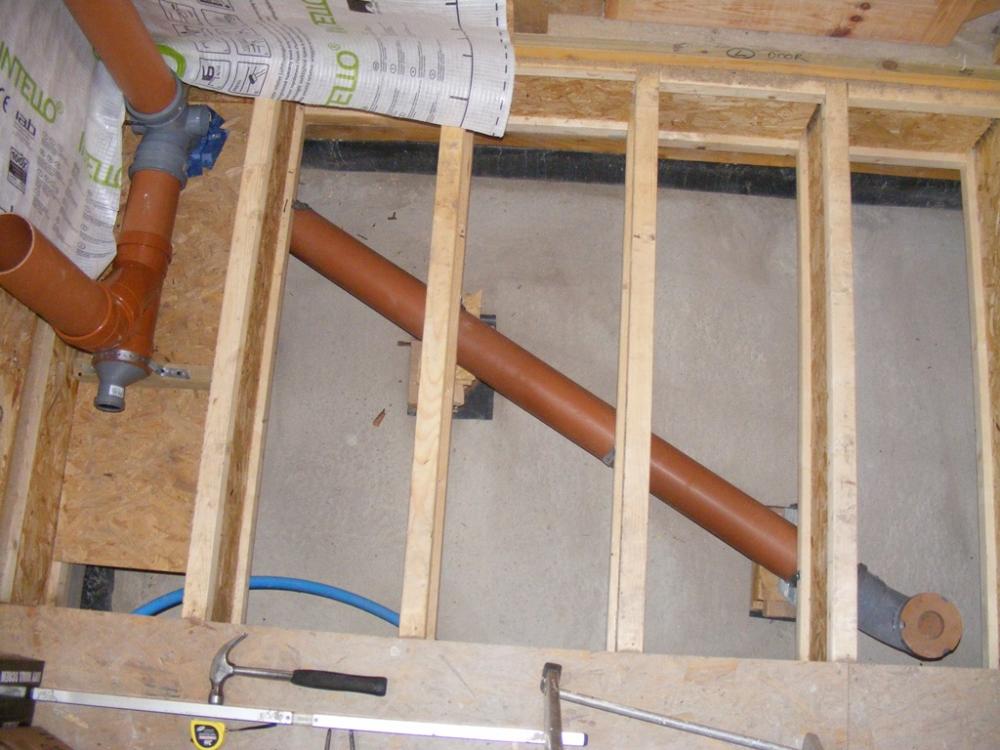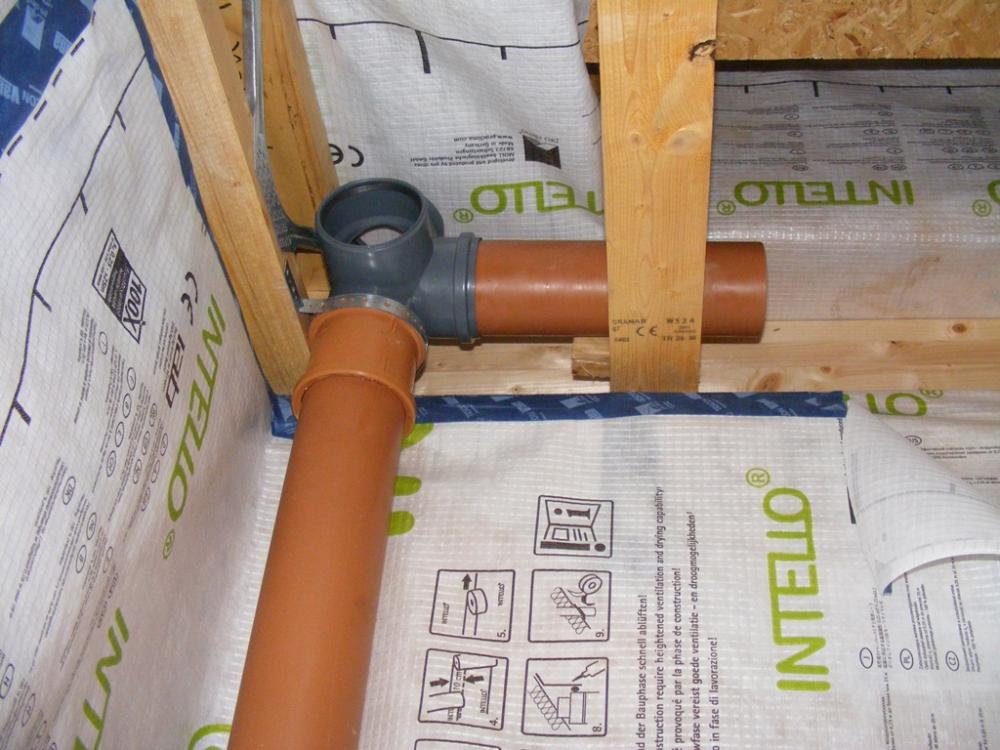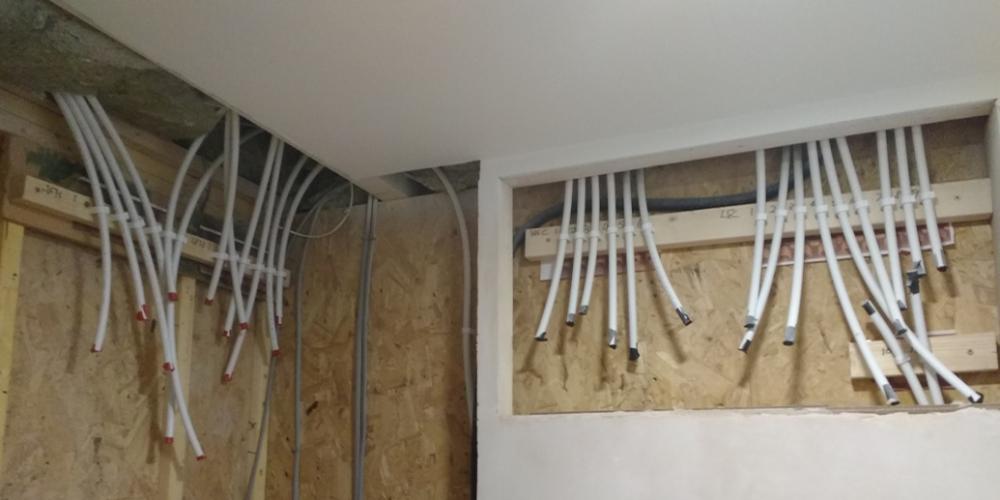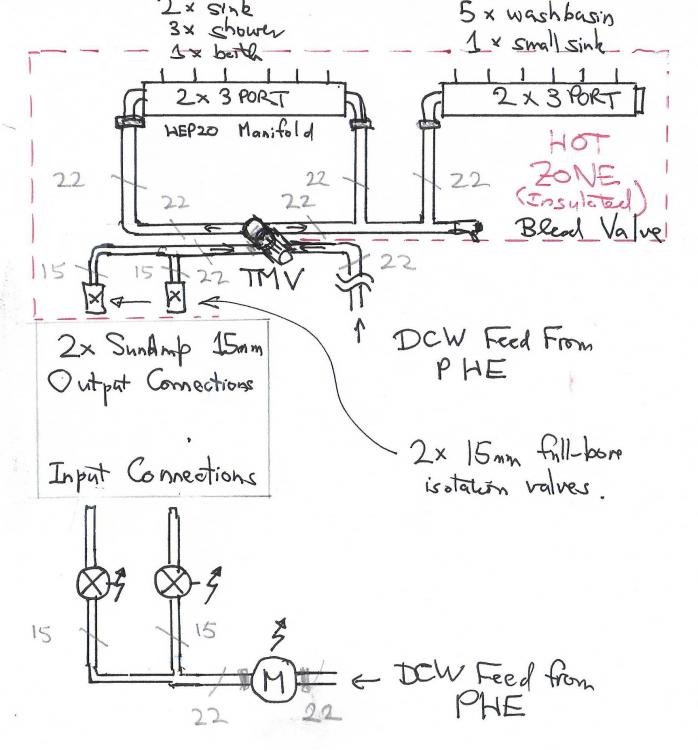Leaderboard
Popular Content
Showing content with the highest reputation on 02/01/17 in all areas
-
Not a lot to tell but I ll fill it with rocks so it's a thermal mass bag2 points
-
That's more to do with cisterns than the ceramics. A lot of the new cisterns do a 4/2.6 flush which isn't enough to clear the pan properly. That Geberit of yours is a 6/4 from memory so 50% more water...2 points
-
2 points
-
You wanted some pictures..... That's the stack rising in the right hand corner. you can see the branch under the floor that leads to the "provision for a shower" drain point. To the left of that is the riser for the WC, the branch and 45 degree bend just fit within the floor make up, allowing for the UFH build up, so the socket of the 45 degree bend will be a few mm above FFL. The 50mm will continue left about a metre before turning upwards to come up under the sink unit. (I don't have any 50mm yet) Looking down from above, that's the branch for the shower. It will remain capped in the joist space and will only ever get connected to if anyone installs a downstairs shower. And the top of the stack. That's the corner branch that started the thread, Left hand outlet will feed toilet #1 and the right hand outlet will branch again to feed toilet #22 points
-
What we found when the seats got broken is the only seat I could find that would fit (top fixing) was a self closing one. Now that just makes you lazy and when you go to a friends house that does not have self closing, you give it a nudge and BANG. Whoops.2 points
-
I am not sure whether this is best done as a blog post or a discussion thread, but since I am as much canvassing feedback and comment, I will start this as a thread and maybe summarise later in a blog post. I want tell a quick story as an introductory analogy. Back around the early 1980s when real computers took up most of a room, "Mini computers" were only the size of filing cabinet and ran at 1 MIP or thereabouts, and the first 5MHz IBM PC had only just been introduced, I remember reading a "futures" paper that took Moore's Law and extrapolated it into the future. What it concluded was that 1 GHz computers would be quite possible in the future, but identified that sticking point would be the memory: because of the speed of light, it would have to be less than 6" away from the processor! Unbelievable. Except that's how all processor boards are laid out today: memory on-chip or right next to it. My current house was designed around the time this paper was published: lots of copper piping and loops, the boiler on one wall, the hot tank 4m away in a cupboard, the kitchen 8m away again in the other direction. So the copper is in a mix of 28, 22 and 15 to get the flow rates -- and lots of copper to heat up on the way to the kitchen taps. Old mind-set. OK, plumbing technology hasn't changed nearly as much as computing, but a lot has changed, though many plumbers still hang onto techniques that were good practice 30-odd years ago. What I've tried to do in this new house is to abandon unnecessary concepts and optimise the system as much as possible for the use we want to put it to. So one core aspect is that we've already planned the house to centralise the wet works as much as practical: the house layout is roughly 3 × 2 tiles on two stories and a 3 × 1 in the warm roof. It is double fronted with living, dining and sleeping to the left and right. The front centre is a hall and landing column giving access to all rooms, and the rear centre contains the groundfloor (GFL) toilet, utility, bathroom, and one en-suite. Another en-suite backs onto it. We're using a HEP2O manifold system, so this means that all of the pipe runs are short, except the 7m run to the kitchen taps and a 6m run to the en-suite in the loft. The only long run of low-flow hot is to the loft en-suite hand basin, so we've just kept it simple and used 15mm HEP2O everywhere. What I want to talk about first in this post is our domestic hot water (DHW) system. It is heavily influenced by a thread where we discussed HEP2O manifold options with @Nickfromwales and others, and the example that he posted on this thread (with my current tails along side for comparison): This second photo is of my GFL toilet. The cold manifolds will be on the right (the two groups are high flow and low flow respectively) in a boxed in section above the Gerberit and the hot ones on the left in what will be the services area some 1.4m wide × 0.65m deep that will house all of our under floorheating (UFH) and waterworks and be separated from the toilet area itself by removable quick release panels. Some of my design drivers / rules are: All of the pipework in the service cupboard will be in copper, and sized 15 / 22 / 28 according to flow rates. My preferred approach is to use end-feed copper joints / fittings except where functional fittings are compression. This being said, I also use occasional compression joins to allow me to make up any soldered sub-assemblies on the bench, so that I don't have to solder in place. The hot runs have been reduced in size to the absolute minimum to avoid waste heating. I am using 2 × SunAmpPV (SAPV) for my DWH heat store. I am metering water flows and temperatures. I am preheating the cold feed for DHW to ~21°C using a plate heat exchanger (PHE) coupled to the UFH slab loops. So I have the 2 × SAPVs each using the supplied 15mm tails to a common 22mm @ ~55°C that is mixed with a 22mm @ ~21°C and fed directly into the DHW manifolds. The SAPVs are on a platform in the cupboard to keep this hot line short and to provide space underneath for the UFH subsystem. Each SAPV has a electronic value on its input feed, so that only one is normally connected in flow. Above a threshold flow rate, the second valve is opened to allow parallel flow from both; the "on-stream" and standby SAPVs are swapped during the day to balance the heat drawn down from the units. The PHE merits some explanation. In the winter our cold supply is typically at 5-7°C mixed which is the boosted to 48°C for supply to the hot taps. So that's a delta of 42°C, say. By using the slab to preheat the cold supply to ~21°C this drops the delta that's drawn from the SAPVs to 27°C and this effectively increases the supply capacity of the SAPVs by just over 50%. This is isn't free of course, because I will still need to add this extra heat to the slab on heating days, but we still effectively get 3 SAPVs capacity for the price of 2, and our maximum hot flow rate is prorated accordingly. On the thermal feed side, the PHE is (always) serially connected in the UFH circuit behind the return UFH manifold. The H/W flow rate is used to create a demand that will override the UFH circulation pump to the on mode. The intelligent charging and 1 / 2 use of the SPVs requires my Home Automation system to collect flow rate and temperature info from these feeds. My original plan was to put the digital meter and electronic valves on the hot output side of the SAPVs, until I had that "Durrrhhh" moment and realised that I could just as easily meter the input cold side. So here is the proposed schematic for my DHW. I have still to select the Digital / pulsed water meter, the valves and the Thermostatic Mixer Valve (TMV). But any personal recommendations / comments will be appreciated. The hot zone (that is pipework over ambient temp, and which must be lagged) comprises the 2 × 6 port manifolds, the TMV, some 1m of 22mm pipe and 1m of 15mm pipe a couple of full bore 15 mm isolation valves and the two flexible couplers to the SAPVs. Arguably, I should do the common section on the output of the TMV in 28mm, but given that its about 5cm long, there doesn't seem a lot of point. I haven't shown the SAPVs because they are just white boxes with some connectors at the back, that the flexible 15mm tails connect to. What I've missed off this diagram is the four temperature sensors: one on the combined input to the SAPVs, one on the combined hot O/P into the TMV and two one each of the output tails from the SAPVs.1 point
-
That's the problem with land, they stopped making it a long time ago. .....unless you're the Chinese government!1 point
-
1 point
-
1 point
-
1 point
-
1 point
-
Post deleted whilst admin gets his offer in... @Trw144 have you got any plain ones without the soapstone outer....?1 point
-
Thanks. I tackled it with a brush and some soapy water and its got 99 percent of it gone. There are a couple of areas where it has a couple of small "splats" - these seem to come off with a sharpe pointy knife but I need to spend some more time on these bits.1 point
-
1 point
-
Sorry, bum steer there. Looked at so many! Best I can source £248.93 all in from two separate sources: http://www.bathroomsandshowersdirect.co.uk/duravit---wall-hung-toilets/starck-3-wall-hung-toilets/duravit-starck-3-222509-wall-hung-pan-with-invisible-fixings-white?gclid=CMjp9Kmn79ECFYe77QodYZ4EIw + https://www.cphart.co.uk/duravit-starck-3-standard-toilet-seat/?SKU=ST306381WW&gsp=1&gclid=CLbRxeur79ECFcew7Qod5MkLkQ1 point
-
1 point
-
@joe90, because I'm German(ish) and have worked there, I can honestly say I worry about the charming faith most UK residents have about German products. Not all are well designed. And thats the key consideration in this case. A treatment plant must be ultra reliable. An as @JSHarris points out, the key parts are not German. If they were, the price would likely be much higher. Be more critical of German stuff. It's OK.1 point
-
That's a nice neat installation! I've added an extract to the cupboard housing our UVC for that very reason - easier now than later.1 point
-
1 point
-
1 point
-
Right, it's not my fault this thread digresses but here goes, it's a gentry, a copy of a 1953 MG TF. Built on the mechanics of a 1968 triumph vitesse 200 ( straight six) and we think it was built in about 1974. Original owner and builder died and it was inherited and put away for years. The gentry has a good reputation as a "good" kit car that does not look like one. Also good is the fact it has my favourite engine, six cylinder triumph, and disc brakes. History here for those interested. http://www.gentrycars.co.uk/documents/Gentry.pdf And pic of what I bought. I intend to put it on the road ( it has a new MOT) but completely rebuild from the chassis up over winter AFTER the house is finished. Purists will sneer as it's not an MG but frankly with the better mechanics and the fact it costs a quarter of an original it ticks my boxes ( and I can mend it with spanners ?)1 point
-
Very true indeed, my partner and I are building an extension, she spent over 70 hours on the planning drawings and about an extra 100 hours on drawing details for the builder. In the end, the builder does not even read them, we have had to make him take down an entire wall because he missed the bridging detail. I have spent about 200 hours on sourcing materials, calling manufacturers etc (not including reading this forum) because in order to build within our budget, we agreed a labour only deal with the builder. We hired a structural engineer which I initially complained was too expensive, after all his input, i think his industry are just not charging enough! Pretty much everyone around me is an Architect (except me), not a single one of them is profitable, in my opinion, they spend 2-3x more time on projects than they bill the client, same goes for structural engineers. I have come to the conclusion that no other profession (lawyers, doctors, bankers, accountants) would do this. For a bit of fun, I would love all members to bill every hour spent on their project from inception to completion at the per hour earnings of your day job (if retired, then earning just before retiring) and add it to the project, you may find your time to be worth a lot in monetary terms. Not to mention, by the very reason you are on this forum means you have gained so much knowledge and advanced insight of how buildings work. I doubt a builder, after spending all day on site grafting would not have the time or energy to go home and spend another 3-4 hours researching new products, bridging details and ideas. On my project, i have found good ideas have come from the everyone all the way down to the labours.1 point
-
@TerryE Cold Supply MDPE 25mm/22mm Stopcock 22mm tee to draincock 22mm PRV with strainer 22mm full bore lever valve (FBLV) (Tee into 15mm feeding toilets - temporary until rainwater installed) At UVC 22mm FBLV Y Strainer 22mm Control Set 22mm PRV - feed to balanced cold on all taps w 22mm FBLV down to 22/15 for all feeds UVC 22mm / 15mm tee (multiples) feeds to taps (isolated) 22mm to ensuite 3 way mixer 22mm to bathroom 3 way mixer Think that's it - for various reasons the rainwater system isn't going in until it's all signed off (Anglian Water being one reason ..) so it looks like we have an unbalanced tee however if it stays long term it will get a 1 bar PRV, otherwise it's on a pump and filter set up.1 point
-
I've just had (this morning) exactly the same correspondence with my accountant. My brother and I are in the same situation as you and your husband and are considered developers as we are building 3 houses for sale and apparently, as such, we are responsible for checking that all our contractors are registered for tax appropriately. I'd rather take this conversation offline at the moment but am happy to share some of the feedback and thoughts we have had on this type of situation. PM me if you would like to follow up. Similarly with anyone else who picks up this thread now or in the future.1 point
-
Anna, because you are building more that a single house and are VAT registered, you are a developer, as Jamie says above. The question WRG to CIS is then whether you are a contractor, or whether you are just hiring sub-contractors, If the latter, then you don't need to bother about CIS, if the former you do. Normally a developer wouldn't also be a contractor, the most common exception is probably small builders who build one or two houses to sell. Earlier today I saw the van of a local builder that I know does "speculative builds" like this, if he's still there when I drive past again later I'll ask him, as he's a nice enough chap and I've helped him out with some supplier advice, so he owes me a favour. As a developer it means you have to follow all the rules that apply to small developers and you don't do things with regard to VAT and other taxes the way a self builder would. You can't, for example, follow the guidance on VAT that applies to self-builders, but you can reclaim your VAT with your regular VAT return, so in that respect you are better off as a developer. However, there are also some downsides. Self-builders can get a self-build warranty from one of the warranty providers, you cannot and will probably have to register/join one of the warranty scheme providers in order to be able to sell the houses with a warranty (which is quite commonly a lender requirement). You can get an alternative to this, like an Architects Certificate or similar, but I think buyers might be a bit wary of a developer who isn't registered with one of the big name providers, like NHBC (not that for a moment I'd recommend them, my experience with them was dreadful)1 point
-
I'm registered under the CIS scheme as a contractor. I had to join the scheme when I was doing a fair bit of work as a subcontractor for a building company. It meant they deducted tax at source from my payments and I had to declare the CIS tax paid on my tax return and it all worked out at the end of the year, i.e. if I had over paid tax through the CIS deductions I got a refund. I have never heard of a self builder having to do this in order to "employ" a sub contractor.1 point
-
So change builders. Or he provides you with invoices. Either answer to that is probably not one you want to hear but if you don't go by the book then HMRC will just come after you for what he technically should be paying anyway.1 point


.jpg.c21f3ac78c9b7efd90cbdcb312744dc5.thumb.jpg.7adcad4c0e384f5ecd7d56b0618df6e5.jpg)











